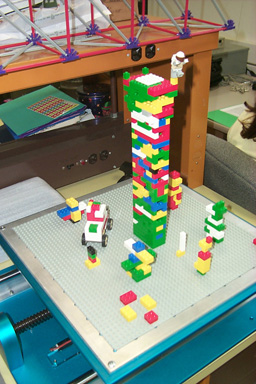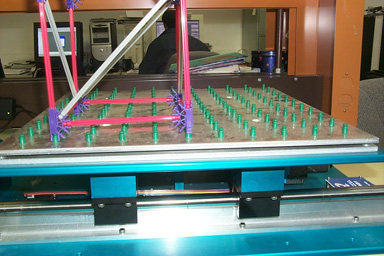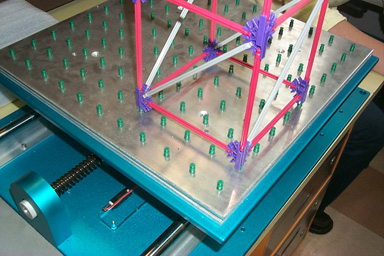Visit
#2: At the end of two weeks, the university visits the classroom for Quake
Day, bringing the Shaking Table and computer and then a presenation on
Earthquake design and Structural Engineering is given to conclude (Part
II). As noted above, students could be taken to the university to
test their buildings if its shaking table is not portable.
 Our experience
has shown that recognition of student effort and acheivement is an important
component of the second visit. So for this visit, the chapter creates
a chart, with the names of each team and three colums for scoring: aesthetics,
earthquake performance and rental value. Prior to testing, secret ballots
are used by the EERI members to vote for the most aesthetically pleasing
building. The vote tally is logged on the chart in front of the class.
Then, the rental values for each building are logged on the chart. Finally,
through the rounds of testing, as the buildings fail, they are crossed
off the chart until one building remains standing. The score card really
helps to foster a spirit of competition and team pride.
Our experience
has shown that recognition of student effort and acheivement is an important
component of the second visit. So for this visit, the chapter creates
a chart, with the names of each team and three colums for scoring: aesthetics,
earthquake performance and rental value. Prior to testing, secret ballots
are used by the EERI members to vote for the most aesthetically pleasing
building. The vote tally is logged on the chart in front of the class.
Then, the rental values for each building are logged on the chart. Finally,
through the rounds of testing, as the buildings fail, they are crossed
off the chart until one building remains standing. The score card really
helps to foster a spirit of competition and team pride.
To recognize the achievements of the building with the most rental value, an honorary business degree is awarded to the students on that team. Similar honorary degrees are presented in architecture for the aesthetic winner and structural engineering for the Shake Off survivor. These can be made with blank certificate paper available at any office supply store, gold foil seals and university logo stickers.



 Our experience
has shown that recognition of student effort and acheivement is an important
component of the second visit. So for this visit, the chapter creates
a chart, with the names of each team and three colums for scoring: aesthetics,
earthquake performance and rental value. Prior to testing, secret
Our experience
has shown that recognition of student effort and acheivement is an important
component of the second visit. So for this visit, the chapter creates
a chart, with the names of each team and three colums for scoring: aesthetics,
earthquake performance and rental value. Prior to testing, secret